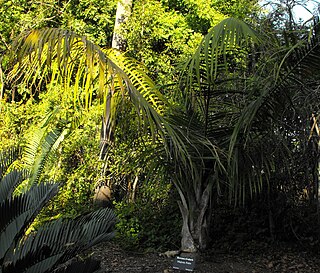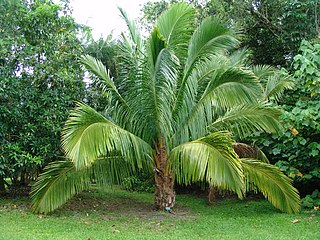Kaliphora madagascarensis is a species of evergreen shrub or small tree. It is endemic to Madagascar, where it inhabits subhumid woodlands and forests in eastern Madagascar, in the provinces of Antananarivo, Antsiranana, Fianarantsoa, and Mahajanga.

Ravenea is a genus of 20 known species of palms, all native to Madagascar and the Comoros.

Adansonia rubrostipa, commonly known as fony baobab, is a deciduous tree in the Malvaceae family. Of eight species of baobab currently recognized, six are indigenous to Madagascar, including fony baobab. It is endemic to western Madagascar, found in Baie de Baly National Park, south. It is associated with well-drained soils and is found in dry and spiny forests. It occurs in the following protected areas: Amoron'i Onilahy, Baie de Baly, Menabe Antimena, Mikea, Namoroka, Ranobe PK 32, Tsimanampesotse, Tsimembo Manambolomaty, Tsinjoriake.
Leptolaena abrahamii is a species of flowering plant in the family Sarcolaenaceae. It is found only in Madagascar. Its natural habitat is mid-elevation humid tropical forests. It is threatened by habitat loss.
Dypsis onilahensis is a species of palm tree in the family Arecaceae. It is endemic to Madagascar as is reflected in the species name (onilahensis) referring to the Onilahy River, south of Toliara. It is threatened by habitat loss.
Dypsis rivularis is a species of flowering plant in the Arecaceae family. It is palm endemic to Madagascar, where it grows in forests near rivers. It is threatened by habitat loss. There are fewer than 100 mature individuals estimated to remain.
Lemurophoenix halleuxii is a species of palm tree, the only species in the genus Lemurophoenix. It is found only in Madagascar. It is threatened by habitat loss and overcollection. There are perhaps 300 mature individuals remaining in the wild.
Melanophylla alnifolia is a species of plant in the Torricelliaceae family. It is endemic to eastern Madagascar. Its natural habitat is tropical moist lowland and montane forests. It is threatened by habitat loss.

Beccariophoenix madagascariensis, commonly known as the coastal beccariophoenix, is a species of flowering plant in the family Arecaceae. It is a large Coconut relative that is vulnerable in its habitat in Madagascar.
Chapelieria is a monotypic genus of flowering plants in the family Rubiaceae. The genus contains only one species, viz. Chapelieria madagascariensis, which is endemic to Madagascar.

Cinnamosma fragrans is a species of flowering plant in the family Canellaceae. It is endemic to Madagascar, where it is commonly known as saro.
Cinnamosma madagascariensis is a species of flowering plant in the family Canellaceae. It is endemic to Madagascar., where it is known as sakaihazo.
Abrus madagascariensis is a plant in the legume family Fabaceae, native to Madagascar. It grows as a herb, shrub or liana.
Gereaua is a monotypic genus of flowering plants belonging to the family Sapindaceae. It only contains one species, Gereaua perrieri(Capuron) Buerki & Callm.
Hartogiopsis is a monotypic genus of flowering plants belonging to the family Celastraceae. It contains only one species, Hartogiopsis trilobocarpa(Baker) H.Perrier.
Pilgerina is a monotypic genus of flowering plants belonging to the family Santalaceae. It only contains one known species, Pilgerina madagascariensisZ.S.Rogers, Nickrent & Malécot
Salvadoropsis is a monotypic genus of flowering plants belonging to the family Celastraceae. It only contains one known species, Salvadoropsis arenicolaH.Perrier
Humbertiodendron is a monotypic genus of flowering plants belonging to the family Trigoniaceae. The only species is Humbertiodendron saboureaui.
Ephippiandra madagascariensis is a species of flowering plant endemic to Madagascar, where it is known as ambora.
Ephippiandra tsaratanensis is a species of flowering plant endemic to the Tsaratanana Massif of northern Madagascar.





